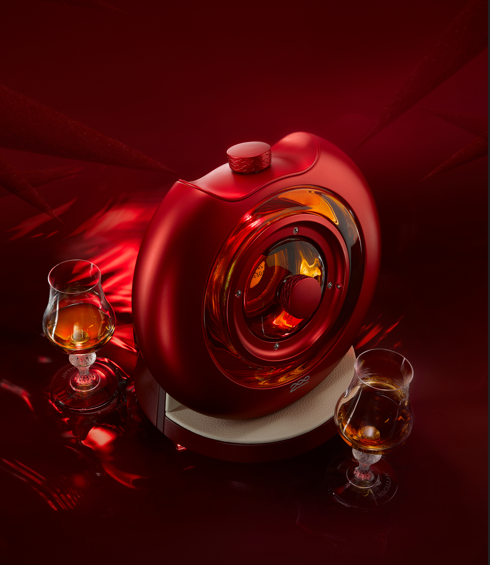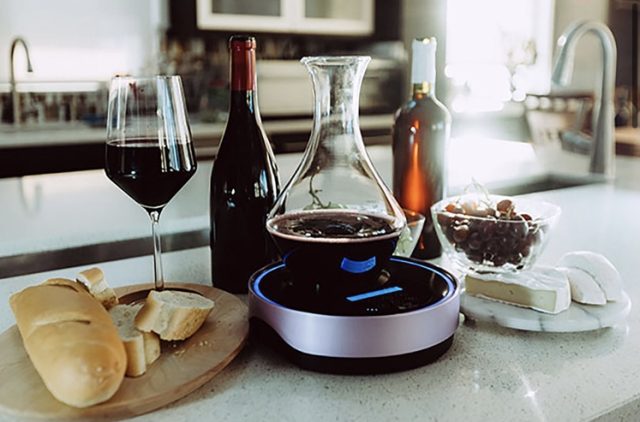5 ways to deep-clean your decanter after Christmas
If your decanter has more curves than a Magic Eight Ball, here’s how to remove wine and whisky stains from the trickiest nooks and crannies.

As drinks brands deploy ever more eyecatching decanter designs to attract luxury spenders, vessels are beginning to incorporate an array of structural twists and turns.
Last year, for example, The Macallan bottled two of its whisky expressions in one bespoke dual-chambered circular decanter. The outer chamber held the 1940 vintage (the distiller’s oldest to date) while a newer release – the 2018 – was encased in the decanter’s inner chamber.
In a similarly extravagant fashion, fellow whisky maker The Dalmore chose to house its single malt in an 80kg glass sculpture co-created with Zaha Hadid Architects. Made from one continuous piece of glass, the detailed sculpture underwent 500 hours of hand polishing, and only three of these unique bottles were made.

While these intricacies turn decanters into true works of art and craftmanship, they can also make them a devil to clean. Try these tricks for a sparkling finish.
Denture cleaning tablets (yes, really)
Denture tablets are useful for cleaning more than just false teeth. They work by effervescing to break down stains. The fizzing action helps to dislodge food and drink particles – the bubbles generated by the tablet can help to lift and remove debris from a decanter’s most difficult-to-reach crevices.
Such tablets often contain ingredients such as sodium bicarbonate (also known as baking soda), which alkalizes water; citric acid which removes stains; potassium persulfate (an oxidizer) and sodium perborate (a peroxide-based bleaching agent). All are useful in making a decanter squeaky clean.
Fill the decanter with warm water, pop in one tablet to dissolve, and leave to soak for at least 30 minutes or overnight if heavily stained. Rinse and dry well.
Baking soda and warm vinegar
If you’re lucky enough to have all your own teeth, try these household ingredients instead.
Add a couple of generous tablespoons of baking soda to the decanter, followed by equal parts warm water and undiluted white vinegar.
The resulting fizzing action created by the baking soda reacting with the water works in the same way as the denture tablets, helping to loosen and lift stains. Meanwhile, the vinegar is an effective, non-toxic way to clean glass. The acidic nature of the vinegar, due to the presence of acetic acid, dissolves dirt, grime, and mineral deposits on glass surfaces, leaving a streak-free shine when properly diluted and wiped away.
In short, the acidity breaks down the residue on the glass, making it easy to remove with a clean cloth.
Vinegar and salt
No baking soda to hand? Substitute it for a handful of coarse salt granules, which act as a gentle exfoliating agent to lift stains from the surface of the glass.
Salt can also help to absorb any moisture or oily residue present in whisky or wine stains, so add the salt to the decanter first, and leave to sit for a while before adding the vinegar and water.
Cleaning experts recommend using kosher salt, a coarse-grained salt often preferred over other salts because of its large flake size and clean flavour. It’s around half as salty as standard table salt, and takes its name from the Jewish tradition of kashrut, which prohibits eating meat that contains blood. The large grains of kosher salt make it suitable for the koshering process of removing blood from meat.
Partner Content
White rice
This kitchen cupboard staple can work wonders in removing stains from awkward curves in a decanter.
Add warm water and a squirt of washing up liquid into the decanter, and throw in half a mug of white rice. The rice acts as an abrasive to clean any areas you can’t reach with a sponge or brush.
Swish the rice around in the decanter for a few minutes, then empty and rinse several times.
Crushed eggshells can also work in the same way as the rice if you have any shells left over from your New Year fry-up.
Rinse and repeat
According to L’Atelier du Vin, a French manufacturer of wine accessories, deep-cleaning a decanter after every three to four uses ensures the removal of invisible deposits and maintains the purity of the glass.
Thorough rinsing and drying is absolutely key, no matter what cleaning ingredients you use. It’s important to rinse several times to ensure that no residues remain that could alter the taste of any future wine.
Dry the decanter completely to avoid moisture build-up and mould formation.
Microfibre cloths can be particularly effective for avoiding water marks and limescale deposits, as they leave no lint behind and absorb moisture well.

Electric decanters: Yes or no?
The drinks business has previously explored whether electric decanters are the future of the on-trade. The creators of these controversial devices claim an electrical decanter can make your wine “taste two to five times better in mere minutes”, but industry professionals are unconvinced.
“It feels like putting the wine in a rocking boat and hoping it will survive the seasickness,” Melody Wong, head sommelier and wine buyer for Carlton Tower, Jumeirah, London, told db.
“Rushing the evolution of a wine is like trying to cook a good ragu quickly. It’ll never taste the same,” added Peter Wallbridge, Spain and South America buyer for UK distributor Enotria & Coe.
The devices work by placing a decanter of wine on a vibrating surface, which jiggles the liquid and is said to speed up the aeration process.
Related news
Glenfarclas Distillery releases 20-year-old Port Pipe Decanter




